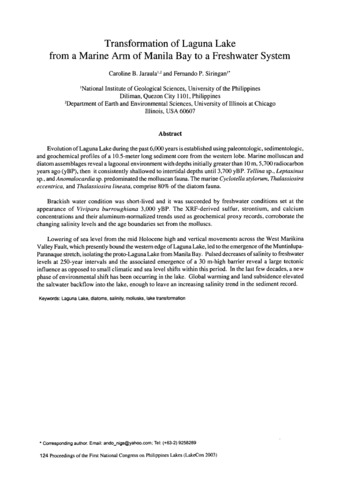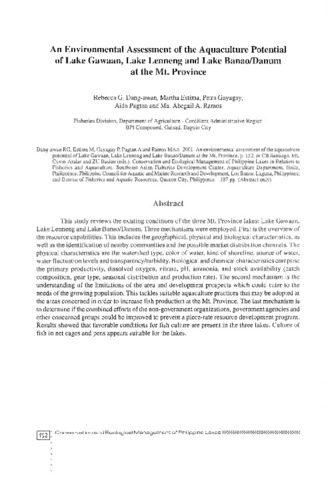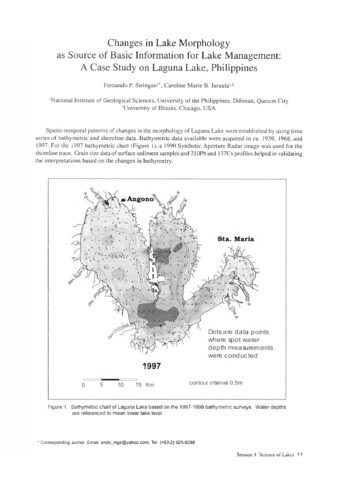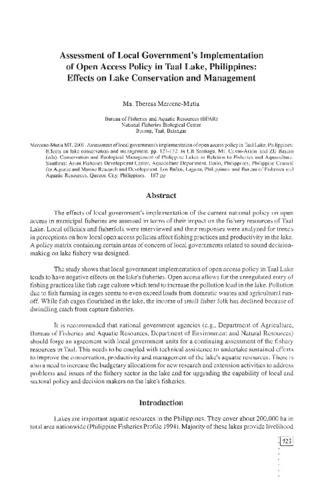Perlihatkan publikasi sederhana
Transformation of Laguna Lake from a marine arm of Manila Bay to a freshwater system
| dc.contributor.author | Jaraula, Caroline B. | |
| dc.contributor.author | Siringan, Fernando P. | |
| dc.contributor.editor | Cuvin-Aralar, Maria Lourdes | |
| dc.contributor.editor | Punongbayan, Raymundo S. | |
| dc.contributor.editor | Santos-Borja, Adelina | |
| dc.contributor.editor | Castillo, Lourdes V. | |
| dc.contributor.editor | Manalili, Eduardo V. | |
| dc.contributor.editor | Mendoza, Marlynn M. | |
| dc.date.accessioned | 2021-07-27T05:52:36Z | |
| dc.date.available | 2021-07-27T05:52:36Z | |
| dc.date.issued | 2005 | |
| dc.identifier.citation | Jaraula, C. B., & Siringan, F. P. (2005). Transformation of Laguna Lake from a marine arm of Manila Bay to a freshwater system. In M. L. Cuvin-Aralar, R. S. Punongbayan, A. Santos-Borja, L. V. Castillo, E. V. Manalili, & M. M. Mendoza (Eds.), Proceedings of the First National Congress on Philippine Lakes (p. 124). Southeast Asian Regional Center for Graduate Study and Research in Agriculture (SEARCA). | en |
| dc.identifier.issn | 1656-8099 | |
| dc.identifier.uri | http://hdl.handle.net/10862/6127 | |
| dc.description | Abstract only. | en |
| dc.description.abstract | Evolution of Laguna Lake during the past 6,000 years is established using paleontologic, sedimentologic, and geochemical profiles of a 10.5-meter long sediment core from the western lobe. Marine molluscan and diatom assemblages reveal a lagoonal environment with depths initially greater than 10 m, 5,700 radiocarbon years ago (yBP), then it consistently shallowed to intertidal depths until 3,700 yBP. Tellina sp., Leptaxinus sp., and Anomalocardia sp. predominated the molluscan fauna. The marine Cyclotella stylorum, Thalassiosira eccentrica, and Thalassiosira lineata, comprise 80% of the diatom fauna. Brackish water condition was short-lived and it was succeeded by freshwater conditions set at the appearance of Vivipara burroughiana 3,000 yBP. The XRF-derived sulfur, strontium, and calcium concentrations and their aluminum-normalized trends used as geochemical proxy records, corroborate the changing salinity levels and the age boundaries set from the molluscs. Lowering of sea level from the mid Holocene high and vertical movements across the West Marikina Valley Fault, which presently bound the western edge of Laguna Lake, led to the emergence of the Muntinlupa-Paranaque stretch, isolating the proto-Laguna Lake from Manila Bay. Pulsed decreases of salinity to freshwater levels at 250-year intervals and the associated emergence of a 30 m-high barrier reveal a large tectonic influence as opposed to small climatic and sea level shifts within this period. In the last few decades, a new phase of environmental shift has been occurring in the lake. Global warming and land subsidence elevated the saltwater backflow into the lake, enough to leave an increasing salinity trend in the sediment record. | en |
| dc.language.iso | en | en |
| dc.publisher | Southeast Asian Regional Center for Graduate Study and Research in Agriculture (SEARCA) | en |
| dc.subject | Laguna Lake | en |
| dc.subject | Lake transformation | en |
| dc.subject | transformation | en |
| dc.title | Transformation of Laguna Lake from a marine arm of Manila Bay to a freshwater system | en |
| dc.type | Conference paper | en |
| dc.citation.spage | 124 | en |
| dc.citation.conferenceTitle | Proceedings of the First National Congress on Philippine Lakes | en |
| dc.subject.asfa | Bacillariophyceae | en |
| dc.subject.asfa | salinity | en |
| dc.subject.asfa | aquatic molluscs | en |
| dc.subject.asfa | lakes | en |
| dc.subject.asfa | fresh water | en |
Files in this item
Publikasi ini ada di koleksi berikut
-
LakeCon2003 [49]
Proceedings of the First National Congress on Philippine Lakes





